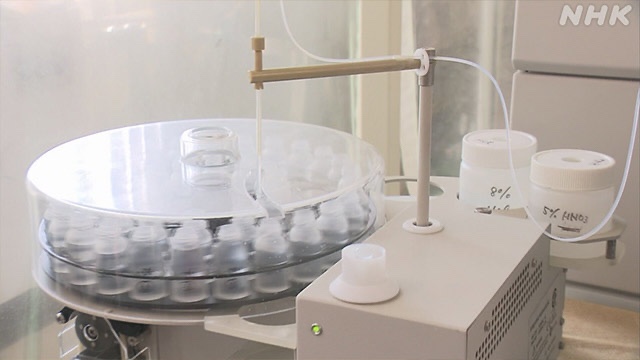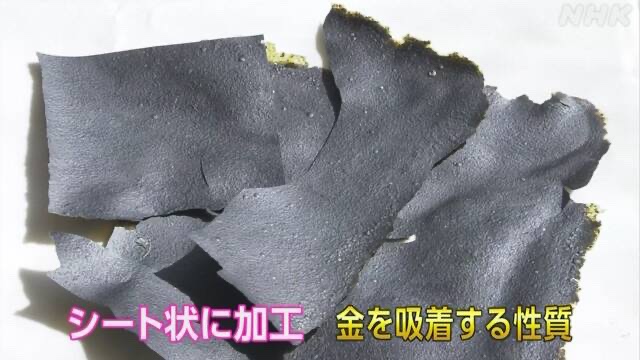


JPN technology: Collecting a large amount of “gold” from hot springs!
– 30 grams can be harvested per ton –
-The deep-sea hydrothermal system is a “natural power plant”-
Japan Agency for Marine-Earth Science and Technology
“IHI”
-A small amount of gold dissolved in hot springs-
How to extract “gold”:
Developed by research teams such as the Japan Agency for Marine-Earth Science and Technology.
Attention is focused on whether it can be established as a new collection method other than mining.
“Gold” Lode:
“Gold” is contained in underground magma and melts into hot water of several hundred degrees.
“Gold” is a vein of “gold” that rises to the surface and cools and solidifies.
Research team:
Considering that “gold is also contained in hot springs,” we searched for a way to collect it.
We focused on a type of “algae” called “cyanobacteria”.
This “cyanobacterium”:
Separating chlorine combined with “gold dissolved in hot springs”,
“It has the property of adsorbing only gold.”
Akita
Tamagawa Hot Spring
We processed cyanobacteria into sheets for up to about 7 months.
An experiment was conducted in which a special sheet was soaked, and “gold” was collected.
At the highest concentration, “30 grams per 1 ton of sheet” can be collected.
Major gold mines in the world:
“The amount that can be extracted from 1 ton of ore is only 3 to 5 grams.”
The cyanobacteria sheet has the potential to become a new method of collecting gold.
Reason for choosing Tamagawa Onsen:
Tamagawa Onsen is a high-temperature hot spring, and gold dissolves more easily in strongly acidic hot springs.
98 degree hot water source:
There is “abundant amount of hot water that springs out 9000 liters per minute”,
“It must be strongly acidic with a pH of 1.2”.
Off the coast of Aogashima, Tokyo
700 meters deep
-Deep sea around 700 meters off the coast of Aogashima, Tokyo-
At a depth of 700 meters, hot hot water erupts.
Using an unmanned submersible, a sheet of “cyanobacteria” was installed,
Experimenting with “gold” collection.
Surrounding rocks:
It contains “an average of 17 grams of gold per ton”.
Next year, we will collect the sheets and check the results.
NHK
https://www3.nhk.or.jp/news/html/20221211/k10013919661000.html
A Gold Rush Will Happen Gold Veins Sleeping in the Deep Sea | NHK
https://www3.nhk.or.jp/news/special/sci_cul/2022/05/special/hydrothermal-chimney-gold/
Technologie japonaise : Collecte d’une grande quantité d'”or” dans les sources chaudes !
– 30 grammes peuvent être récoltés par tonne –
-Le système hydrothermal sous-marin est une “centrale électrique naturelle”-
Agence japonaise pour les sciences et technologies marines et terrestres
“IHI”
-Une petite quantité d’or dissoute dans des sources chaudes-
Comment extraire “l’or”:
Développé par des équipes de recherche telles que l’Agence japonaise pour les sciences et technologies marines et terrestres.
L’attention est portée sur la question de savoir s’il peut être établi comme une nouvelle méthode de collecte autre que l’exploitation minière.
Filière “Or”:
“L’or” est contenu dans le magma souterrain et fond dans une eau chaude de plusieurs centaines de degrés.
“L’or” est une veine “d’or” qui remonte à la surface, se refroidit et se solidifie.
L’équipe de recherche:
Considérant que “l’or est également contenu dans les sources chaudes”, nous avons cherché un moyen de le collecter.
Nous nous sommes concentrés sur un type “d’algue” appelé “cyanobactérie”.
Cette “cyanobactérie”:
Séparer le chlore combiné à “l’or dissous dans les sources chaudes”,
”Il a la propriété de n’adsorber que l’or.”
Akita
Source chaude de Tamagawa
Nous avons transformé les cyanobactéries en feuilles pendant environ 7 mois.
Une expérience a été menée dans laquelle une feuille spéciale a été trempée et “l’or” a été collecté.
A la concentration la plus élevée, “30 grammes pour 1 tonne de feuille” peuvent être collectés.
Principales mines d’or dans le monde :
“La quantité qui peut être extraite d’une tonne de minerai n’est que de 3 à 5 grammes.”
La feuille de cyanobactéries a le potentiel de devenir une nouvelle méthode de collecte de l’or.
Raison du choix de Tamagawa Onsen :
Tamagawa Onsen est une source chaude à haute température, et l’or se dissout plus facilement dans les sources chaudes fortement acides.
Source d’eau chaude à 98 degrés :
Il y a “une quantité abondante d’eau chaude qui jaillit à 9000 litres par minute”,
“Il doit être fortement acide avec un pH de 1,2”.
Au large d’Aogashima, Tokyo
700 mètres de profondeur
-Mer profonde à environ 700 mètres au large d’Aogashima, Tokyo-
À une profondeur de 700 mètres, de l’eau chaude jaillit.
A l’aide d’un submersible sans pilote, une nappe de “cyanobactéries” a été installée,
Expérimenter avec la collection “or”.
Rochers environnants :
Il contient “une moyenne de 17 grammes d’or par tonne”.
L’année prochaine, nous collecterons les feuilles et vérifierons les résultats.
NHK
Une ruée vers l’or se produira Veines d’or dormant dans les profondeurs de la mer | NHK
Japanische Technologie: Sammeln einer großen Menge “Gold” aus heißen Quellen!
– Pro Tonne können 30 Gramm geerntet werden –
-Das Hydrothermalsystem der Tiefsee ist ein „Naturkraftwerk“-
Japan Agency for Marine-Earth Science and Technology
“IHI”
-Eine kleine Menge Gold in heißen Quellen gelöst-
So extrahieren Sie “Gold”:
Entwickelt von Forschungsteams wie der Japan Agency for Marine-Earth Science and Technology.
Im Fokus steht die Frage, ob es sich als neue Erfassungsmethode neben dem Bergbau etablieren kann.
“Gold”-Ader:
„Gold“ ist im unterirdischen Magma enthalten und schmilzt zu mehreren hundert Grad heißem Wasser.
„Gold“ ist eine „Goldader“, die an die Oberfläche steigt und abkühlt und sich verfestigt.
Forschungsgruppe:
In Anbetracht der Tatsache, dass “Gold auch in heißen Quellen enthalten ist”, haben wir nach einer Möglichkeit gesucht, es zu sammeln.
Wir konzentrierten uns auf eine Art von „Algen“ namens „Cyanobakterien“.
Dieses “Cyanobakterium”:
Trennung von Chlor in Verbindung mit „in heißen Quellen gelöstem Gold“,
„Es hat die Eigenschaft, nur Gold zu adsorbieren.“
Akita
Heiße Quelle von Tamagawa
Wir haben Cyanobakterien bis zu etwa 7 Monate zu Blättern verarbeitet.
Es wurde ein Experiment durchgeführt, bei dem ein spezielles Blatt eingeweicht und “Gold” gesammelt wurde.
Bei der höchsten Konzentration können „30 Gramm pro 1 Tonne Blech“ gesammelt werden.
Größte Goldminen der Welt:
“Die Menge, die aus 1 Tonne Erz gewonnen werden kann, beträgt nur 3 bis 5 Gramm.”
Das Cyanobakterienblatt hat das Potenzial, eine neue Methode zum Sammeln von Gold zu werden.
Gründe für die Wahl von Tamagawa Onsen:
Tamagawa Onsen ist eine heiße Quelle mit hoher Temperatur, und Gold löst sich leichter in stark sauren heißen Quellen auf.
98 Grad heiße Wasserquelle:
Es gibt “eine reichliche Menge an heißem Wasser, das 9000 Liter pro Minute entspringt”,
“Es muss stark sauer sein mit einem pH-Wert von 1,2”.
Vor der Küste von Aogashima, Tokio
700 Meter tief
-Tiefsee etwa 700 Meter vor der Küste von Aogashima, Tokyo-
In einer Tiefe von 700 Metern bricht heißes heißes Wasser aus.
Mit einem unbemannten Tauchboot wurde eine Schicht “Cyanobakterien” installiert,
Experimentieren mit “Gold”-Sammlung.
Umliegende Felsen:
Es enthält „durchschnittlich 17 Gramm Gold pro Tonne“.
Nächstes Jahr werden wir die Blätter einsammeln und die Ergebnisse prüfen.
NHK
Ein Goldrausch wird passieren Goldadern schlafen in der Tiefsee | NHK
Scientists in Japan say:they have found a way to extract gold from hot springs
NHK WORLD-JAPAN News
Scientists in Japan say
they have developed a way to extract gold from the water at hot springs.
The researchers are from
the Japan Agency for Marine-Earth Science and Technology, or JAMSTEC, and major machinery maker IHI.
Molten gold exists in magma deep beneath the Earth’s surface.
The precious metal
is believed to seep into superheated hydrothermal water, slowly rise to the surface and solidify to form veins in rock.
The researchers consider
hot springs water to be a potential source of this gold.
They noted that “cyanobacteria,”
also called blue-green algae,
could be used to extract the metal. They say the algae adsorbs gold by separating it from chlorine and other elements.
The team processed the algae into sheets, which were then soaked in a hot spring in Japan’s northern prefecture of Akita for up to seven months.
The team says
as much as 30 grams of gold were extracted from one ton of the sheets. In the world’s major gold mines,
between three to five grams of gold are said to be found per ton of ore.
The team plans to conduct
more experiments to establish the technology.
Nozaki Tatsuo from JAMSTEC says
the researchers confirmed that the algae can adsorb gold, and that he expects it can be used to collect the metal.
IHI official Fukushima Yasuyuki says
the result was far better than expected.
He expressed the hope that the technology can be developed further to contribute to the sustainable use of natural resources.